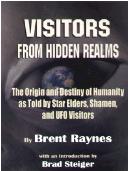 | ||||||||||
| ||||||||||
 | ||||||||||
VISITORS FROM HIDDEN REALMS Discover the connection between UFO visitors and shamanic lore! Brent Raynes' stunning book—intro. by Brad Steiger. | ||||||||||
| Visitors from Hidden Realms: The Origin and Destiny of Humanity As Told by Star Elders, Shamen, and UFO Visitors | ||
The Ongoing Peruvian Whistling Vessel Mystery and Controversy Various researchers like Swiss anthropologist Jeremy Narby have marveled at the chemical sophistication of Amazonian shamans in creating the powerful hallucinogenic ayahuasca brew that is created from two different plants and long used in shamanic ceremonies. One contains DMT (dimethyltryptamine) and the other is a vine that serves to inactivate the stomach enzyme monoamine oxidase (which would ordinarily block the DMT from affecting the brain). Thus out of one estimate of some 80,000 Amazonian plant species, these so-called “primitives” selected the precise vine that makes this psychedelic experience possible. A very interesting article entitled Ayahuasca, shamanism and curanderismo in the Andes by Steve Mizrach can be read simply be going to: www.biopark.org/peru/ayashaman.html. Recent books that describe and explore ayahuasca and other consciousness altering substances used in shamanic practices include Supernatural by Graham Hancock and The Cygnus Mystery by Andrew Collins Recently I was told about an ayahuasca ceremony that is to be conducted here in the Southeast, to be led I understand by a couple of genuine Peruvian shamans, and I was also told that they intended to use replicas of the Peruvian whistling vessels during the ceremony. I found this quite interesting and I reflected on something Don Wright had shared with me in a telephone conversation sometime back. I sent him an email to question him further on the matter. Do the “songs” sung by Peruvian shamans conducting ayahuasca ceremonies shed any insight into the usage of the pre-Columbian Peruvian whistling vessels? “Jicaro are the ayahuasca ‘songs’ the ayahuasquero ‘sings’ during the ceremony,” Don Wright of Silvery City, New Mexico explained to me. Don has been manufacturing replicas of these whistling vessels himself since his own profound experience with them back in 1980. “They are similar in concept to the Peyote songs that are sung by a leader of a medicine meeting of Native Americans. In the ayahuasca ceremonies I’ve attended, the jicaro often include various sounds the shaman makes which, to me, seemed to be an attempt (although unconsciously by the shaman) to reproduce the vessels. My belief is that because the conquistadores would punish vessel users with death because they would consider the vessels ‘religious effigies,’ the ayahuasquero began utilizing sounds produced by mouth instead.” Don even shared some details of his own experiences with ayahuasca. “My experiences have been the ability to see everyone in the room and watch the shaman while my eyes were closed and my head cradled in my arms, to see almost electrical energy being broadcast to me by the shaman and experiencing it rushing though my body, to watch the shaman be on one side of the room, singing, and then instantly be on the other side of the room, etc.,” Don wrote. “I have also experienced the vessels after consuming ayahuasca, and the power of the vessels to open that alternate realm that they open was incredible.” Recently I’ve had contact with a Dr. James G. Matlock, a cultural anthropologist who lives with his Peruvian wife Carmen over in North Carolina. Together they operate a business (Don Pepito Imports LLC) that imports crafts from Peru. Dr. Matlock wrote (01-11-07): “Statnekov claims that the use of these whistles went out with the Spanish conquisadores and (in his writings at least) doesn’t seem to appreciate that they are still used by practicing shamans for ritual purposes in Peru. Originals were made as late as the Inca, though perhaps not after the Spanish arrived. Since both replicas and the originals that can be found are used today I suspect that they never went out of use, but that they merely went underground. ….Now, in Peru, these silbawhistling vessels are generally used individually, not played in groups of seven or five, as Statnekov and his disciple Wright present. The numbers seven and five have no significance in Andean cosmology and metaphysics. They are however sometimes played in a group. This occurred when the last President of Peru (the first President who had Andrean roots) was inaugurated. A group of Cusco area shamans got together and played their silbadores. But this is not the way they are used day-to-day.” On February 25th, just back from Peru, Dr. Matlock had some additional comments and information to convey. He wrote: “I went back to Peru (last ten days of January) and had the chance not only to meet a maker of the silbadores in Lima but also to go up to Chiclayo, which is on the north coast and is the center of the shamanic tradition most closely associated with these vessels. I have been researching these vessels on trips to Peru for the last couple of years but this is the first time I had a chance to go there and to ask shamans and curanderos themselves about the vessels and how they used them. I confirmed things I had heard before but also learned that all the vessels (not just certain kinds) are used for calling spirits, and that the two hole ones are for calling the spirits of a man and a woman in order to bring them together, things I had not heard before. I asked about the posited psycho-acoustical effect, and they scoffed at this, and I heard the same from Carmen (who has been talking to people for me in Lima) and a buyer we have up in Piura, further to the north, who is in touch with another maker we use. So now I have both several denials of an intended psycho-acoustical effect, and the explanation from a practitioner that they are used for calling spirits… I no longer think that Statnekov is correct about that. I think that these vessels have most likely always been used as they are now.” I questioned Dr. Matlock about an earlier statement he made about how the two-hole vessels might cause “a sort of binaural beat effect,” to which he responded, “I do say that they might, but I don’t know that they do, and in any event it is clear that that is not their intent.” Though questioning the presumed psycho-acoustical properties of the Peruvian whistling vessels, I don’t see Dr. Matlock’s comments in anyway extinguishing the mystery and controversy surrounding these magnificent artifacts. Both parties agree on their shamanic usage, even their presumed use for “calling spirits,” and both parties use them for spiritual purposes. On the psycho-acoustical question, it can be argued that the modern vessel makers in Peru are simply not following the exact same tuning procedures as their ancient ancestors did. But whatever the explanation is scientifically or spiritually, the Peruvian whistling vessels have been reported causing profound spiritual and transformational experiences and insights in quite a number of people. I’ve gotten to introduce quite a few first timers myself to the whistling vessel experience since August 2005. I’ve also presented them at four ARE (Association for Research and Enlightenment) functions, including the ARE sponsored UFO Conference at their international headquarters in Virginia Beach, Virginia, back on December 3, 2005. Just as I’m finishing this part of the article up, Dr. Matlock (whom I had just emailed regarding the unresolved aspect of the psycho-acoustical question) wrote me: “There is no way to be sure that contemporary shamans were using them as they were used in the past either. However, their explanation does make sense, and more sense anthropologically-speaking, than the psycho-acoustical explanation, which is one of the reasons that Statnekov ran into so much resistance from the academic establishment. Until the modern replicas are compared to the originals we can’t answer the argument that the old ones were better made, but I have heard originals played, and there is no difference to the ear.” Anyone interested in learning more about Daniel Statnekov’s journey and psycho-acoustical theory (which was also studied at UCLA) is urged to read his book, Animated Earth: A Story of Peruvian Whistles and Transformation. You may also want to visit his website: www.statnikov.com. In addition, Don Wright maintains a website at: www.entheosound.com. | ||
